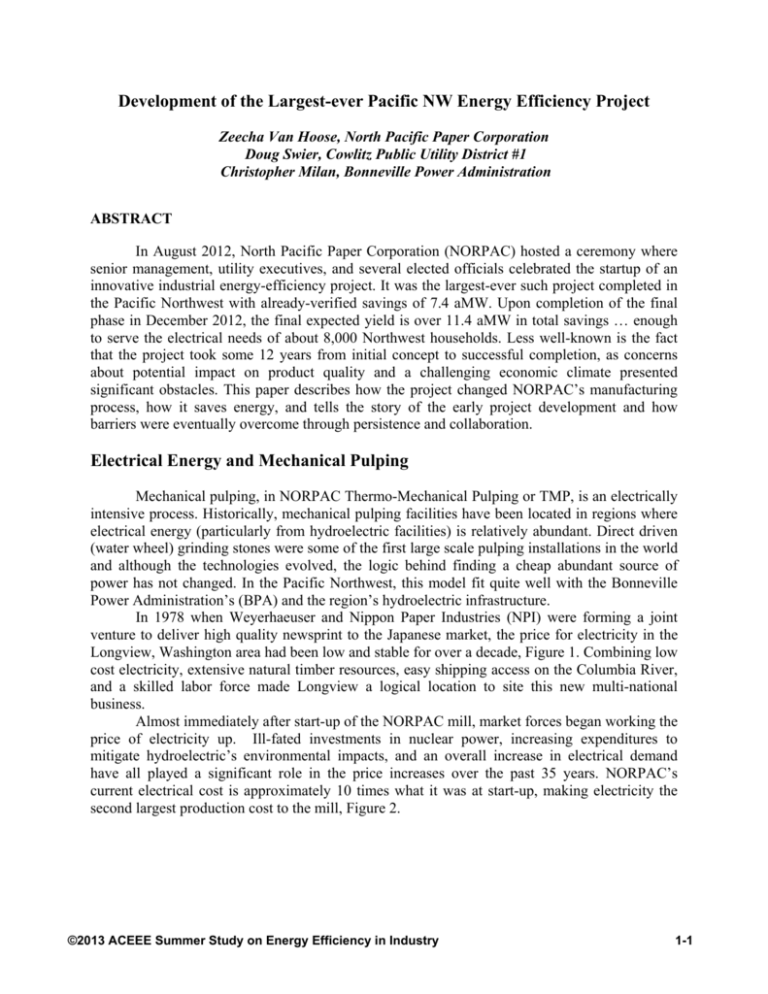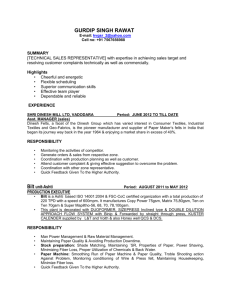Development of the Largest-ever Pacific NW Energy Efficiency Project
advertisement

Development of the Largest-ever Pacific NW Energy Efficiency Project Zeecha Van Hoose, North Pacific Paper Corporation Doug Swier, Cowlitz Public Utility District #1 Christopher Milan, Bonneville Power Administration ABSTRACT In August 2012, North Pacific Paper Corporation (NORPAC) hosted a ceremony where senior management, utility executives, and several elected officials celebrated the startup of an innovative industrial energy-efficiency project. It was the largest-ever such project completed in the Pacific Northwest with already-verified savings of 7.4 aMW. Upon completion of the final phase in December 2012, the final expected yield is over 11.4 aMW in total savings … enough to serve the electrical needs of about 8,000 Northwest households. Less well-known is the fact that the project took some 12 years from initial concept to successful completion, as concerns about potential impact on product quality and a challenging economic climate presented significant obstacles. This paper describes how the project changed NORPAC’s manufacturing process, how it saves energy, and tells the story of the early project development and how barriers were eventually overcome through persistence and collaboration. Electrical Energy and Mechanical Pulping Mechanical pulping, in NORPAC Thermo-Mechanical Pulping or TMP, is an electrically intensive process. Historically, mechanical pulping facilities have been located in regions where electrical energy (particularly from hydroelectric facilities) is relatively abundant. Direct driven (water wheel) grinding stones were some of the first large scale pulping installations in the world and although the technologies evolved, the logic behind finding a cheap abundant source of power has not changed. In the Pacific Northwest, this model fit quite well with the Bonneville Power Administration’s (BPA) and the region’s hydroelectric infrastructure. In 1978 when Weyerhaeuser and Nippon Paper Industries (NPI) were forming a joint venture to deliver high quality newsprint to the Japanese market, the price for electricity in the Longview, Washington area had been low and stable for over a decade, Figure 1. Combining low cost electricity, extensive natural timber resources, easy shipping access on the Columbia River, and a skilled labor force made Longview a logical location to site this new multi-national business. Almost immediately after start-up of the NORPAC mill, market forces began working the price of electricity up. Ill-fated investments in nuclear power, increasing expenditures to mitigate hydroelectric’s environmental impacts, and an overall increase in electrical demand have all played a significant role in the price increases over the past 35 years. NORPAC’s current electrical cost is approximately 10 times what it was at start-up, making electricity the second largest production cost to the mill, Figure 2. ©2013 ACEEE Summer Study on Energy Efficiency in Industry 1-1 Figure 1. Electricity Pricing, 1960 to Projected 2016 Figure 2. Electricity as a Percentage of Production Costs in 2012 1-2 ©2013 ACEEE Summer Study on Energy Efficiency in Industry Innovating for Business Viability Newsprint demand has been steadily declining since 2000. A consistent oversupply in the market has kept prices low. At the same time, chip, recycle paper, and electrical costs have all been increasing. To survive in the paper business, NORPAC had to innovate on all fronts. With a total TMP electrical demand of 160 MW, energy reduction in this area has a significant potential to reduce operating costs. However, energy reduction in TMP mills generally results in degradation of pulp quality. A reduction in quality would be unacceptable as the mill is also expanding product diversity to replace newsprint. Figure 3. North American Newsprint Shipments vs. Capacity through April 2012 In 1999, a research technical paper presented at the International Mechanical Pulping Conference demonstrated that passing a portion of the pulp around the second stage of processing (refining) saved energy and did not negatively impact final quality (Corson, IMPC 1999). At that time, there were no commercial applications of this technology. Due to some relatively unique process configurations, separating pulp fibers ahead of the secondary stage of refining was an easier process modification at NORPAC than it would be at other mechanical pulp mills. NORPAC began pursuing this concept through innovative use of existing technologies. ©2013 ACEEE Summer Study on Energy Efficiency in Industry 1-3 Figure 4. Interstage Screening Process Flow As shown in Figure 4, the red line represents pulp fibers that, as a result of the project, would be bypassing the second stage of refining. Each stage of refining uses 1000 kWhr per metric ton of pulp fiber. NORPAC’s TMP 1 and TMP 2 mills produce over 1500 metric tons of pulp per day. Bypassing a percentage of the total pulp stream around the second stage of refining had the potential to significantly reduce the total amount of applied power. Technical Challenges Conceptually, separating the finest material coming from the first, primary, stage of refining was feasible; however, the technical challenges were significant. Identifying sorting technology that could selectively segregate the material that did not need more processing to produce usable fiber from the material that did necessitated mill and pilot plant trials. Both mill and pilot plant trials are expensive undertakings, with each trial costing more than $40,000 in direct costs. Because of the significant energy savings and economic impact of this project to the region, both Cowlitz PUD and the BPA contributed to covering the costs of developing technical data to support the project. Beginning in 2001, mill trials showed the potential for greater than 15% by mass bypass of the secondary refiners. Small scale trials quantified the energy savings and proved that the quality of the final pulp product would not be compromised by inserting a screening stage into the pulping process. However, a new challenge presented itself. In order to separate the finest fiber material from the pulp stream using the identified technology, the pulp needed to be diluted to approximately 98.5% water. Breaking into the water loop to accomplish this dilution would result in a significant increase in the amount of negative wood chemistry that would reach the paper machines. Wood chemistry negatively interacts with the paper making process and can cause defects in the paper produced. Mitigating the impacts of wood chemistry on the paper machines requires the use of expensive chemical additives. Interstage Screening, as it was proposed, could easily increase the production costs on the paper machine to the point of overshadowing the TMP energy savings. Each of the traditional approaches to ‘cleaning up’ the pulp was cost prohibitive. As a result, the project was put on hold for almost seven years while various approaches to reducing this risk were evaluated. At the same time that Interstage Screening was being looked at as a potential for energy reduction, a separate project called Peak Brightness, was being evaluated as a cost effective way to increase the final brightness of the TMP mills. A number of approaches to increasing 1-4 ©2013 ACEEE Summer Study on Energy Efficiency in Industry brightness were trialed, both in the laboratory and in the mill. The most promising of these technologies was Chip Pretreatment. Chip Pretreatment steams and squeezes wood chips to prepare them for bleaching. By steaming and squeezing the chips, a large amount of the negative wood chemistry is removed, increasing the responsiveness to bleaching chemistry. Figure 5. Chip Pretreatment Process Flow Recognizing that Chip Pretreatment might reduce the wood chemistry contamination to a point that Interstage Screening’s impact on the water loop would be tolerable, another series of experiments were done to prove that was the case. Compiling this data proved that Chip Pretreatment allowed Interstage Screening to become a viable project. In combining Chip Pretreatment and Interstage Screening, NORPAC was able to accomplish multiple critical goals: Improved bleach response – lower operating cost on existing products Increased bleaching capability – new product development opportunities Decreased electricity usage – lower operating cost Business Challenges Most of the research and development work for the combined Chip Pretreatment and Interstage Screening project was being completed in 2009, just as the business climate was at an extreme low point. Capital funding was tight for even small projects. Chip Pretreatment and Interstage Screening for two TMP mills would require in excess of $60 million dollars of capital funding. To generate business level support all the way through three organizations, NORPAC business management, NPI board of directors, and Weyerhaeuser board of directors, required a ©2013 ACEEE Summer Study on Energy Efficiency in Industry 1-5 substantial business case. Integral to that business case was utility support. The Bonneville Power Administration (BPA) funded the on-site engineer for two years to work the internal processes to gain project approval. A number of policy and legislative initiatives encourage energy conservation in the Pacific Northwest. BPA is mandated to obtain cost effective conservation through the Pacific Northwest Electric Power Planning and Conservation Act. BPA administers conservation programs through their serving utilities through a program called Energy Smart Industrial (ESI). In addition, Cowlitz PUD is required to obtain cost effective conservation through Washington State’s voter approved Initiative-937. These joint goals provided alignment for increased utility support of end-user conservation programs. NORPAC had participated in the combined BPA/CPUD conservation programs for years and had an established record of delivering cost effective conservation. Gaining support for a project of the size of Chip Pretreatment Interstage Screening began with the inclusion of the utilities technical representatives early in the project. Key site support personnel for Cowlitz PUD and the BPA worked with the mill engineering staff from 2007 through 2009 to contribute to the technical development of the project and assist in building communication links with upper-level management for all of the entities involved. Chip Pretreatment Interstage Screening had significant energy and non-energy benefits; however, most projects at this time required a minimum 25% return on investment (ROI) to be considered. A $60 million project was subjected to a higher hurtle rate than the standard 25%. In order to generate that type of return, NORPAC needed to have substantial incentive funding. Most projects under the ESI program receive $0.25 per annual kilowatt hour saved (with incentives capped at 70% of project cost). As a very custom project, a final package of incentives was negotiated prior to submitting the project to the various boards. An incentive rate of $0.21 per annual kilowatt hour, a ceiling on the incentive rate was set, additional direct utility district funding was included, and progress payments were used to help the mill’s cash flow during the course of the project. With a firm incentive package in place, the project was put before the boards of directors at the end of 2009. Each segment of the management structure supported the project. A strong technical package was backed with firm economics. One concession that the mill made was to stage the project construction such that the TMP 1 mill was built first and measured and verified prior to construction beginning on TMP 2. This insured that the claimed benefits would be realized by the project ahead of the additional $30 million expenditure for TMP 2. Project Summary Integrating substantial equipment and process changes into a continuously operating facility was a tremendous challenge. NORPAC does not generally take extended full mill outages. Each process area completes maintenance and project tasks during short, twelve-hour, outages taken five to six weeks apart. As equipment was purchased, beginning in January 2010, project managers and mill personnel worked to align the installation and switch-overs to occur during these narrow windows. A complete replacement of the chip conveying system from the chip storage silos to the TMP mills was finished in May 2011. This reconfigured the chip flow to reach the top of the new Chip Pretreatment structure. A number of bypass options were maintained for a number of months to allow for a staged checkout and startup of the Chip Pretreatment system. By 1-6 ©2013 ACEEE Summer Study on Energy Efficiency in Industry conveying the chips rather than using pneumatic blowers, this part of the project yielded 3,356,988 kilowatt hours per year of site electrical energy savings. Figure 6. Chip Pretreatment Structure Full operation of the Chip Pretreatment system followed quickly. A number of operational issues were experienced early during startup; however, by June of 2011, TMP 1 Chip Pretreatment had stable and reliable operation. Inserting Interstage Screening into the operating TMP 1 mill required extensive planning and full utilization of each maintenance outage. From a process perspective, the Interstage Screening system follows the primary stage of refining. Figure 7 shows both the primary (left) and secondary (right) refiner lines at NORPAC. ©2013 ACEEE Summer Study on Energy Efficiency in Industry 1-7 Figure 7. TMP Refiners at NORPAC Construction of the Interstage Screening system was completed in parallel to the running system by installing a relatively small amount of addition piping and valving. These additional costs proved cost effective as the system could be commissioned with minimal impact to the full mill production and quality. Figure 8. Interstage Screening MuST Screen During Construction Interstage Screen commissioning began in June 2011 with full, stable operation by August 2011. A measurement and verification period from August 2011 through January 2012 was used for quantification of the total project savings. On smaller scale projects, project electrical savings is typically measured at the individual equipment level with stand-alone power 1-8 ©2013 ACEEE Summer Study on Energy Efficiency in Industry logging equipment. Due to the extensive process changes and large systems impacts with this project, a sub-meter approach was taken to the measurement and verification period. NORPAC’s electrical demands, particularly in the TMP mill, are large enough to have substation level area power meters. Each of these meters are revenue grade equipment and extensively maintained. Using these meters and the production rate measurement in the TMP 1 mill, a quantification of the change in the amount of power applied per production ton was possible. Figure 9. Final Result TMP 1 – 60,143,275 Kilowatt Hours per Year Applying the savings per ton over the entire production of the TMP 1 mill resulted in 60,143,275 kilowatt hours grid-level savings per year. TMP 1 Chip Pretreatment and Interstage Screening was a success on multiple levels. In excess of 128,000 hours of on-site work by contractors was completed safely. Each of the components started up on-time. The total electrical energy savings was above target and the nonenergy benefits exceeded expectation. As a result, approval of the TMP 2 project came within six months of the TMP 1 startup. Construction of TMP 2 Chip Pretreatment and Interstage Screening was complete in November 2012. Measurement and verification of the electrical energy savings associate with the TMP 2 phase of the project will be complete towards the end of 2013; however, early indications are consistent with the savings from TMP 1. ©2013 ACEEE Summer Study on Energy Efficiency in Industry 1-9 Conclusion Competitive manufacturing in the current business environment requires innovation at every level of the organization. Chip Pretreatment and Interstage Screening used existing technologies in new ways to reduce cost and improve the capability of the manufacturing system. Leveraging synergies in business objectives between the electrical generators, utilities, and endusers to meet multiple goals keeps costs down for all electricity users and maintains a competitive edge for regional manufacturers. Most of all, moving a project of this size and complexity forward required time and teamwork. Bringing all parties into the conversation early in the development of the project allowed innovation in marketing the project to management and a more comprehensive look at how the savings would be measured and reported. References Corson, Stuart R. IMPC 1999. Process Impacts on Mechanical Pulp Fibre and Sheet Dimensions. Quanqing Zha, et al 2008. Refining of Long Fibre Fractions After Fractionation. Ferluc, Alexandre, et al PAPTAC 2008. Optimization of TMP Process and Pulp Quality by Means of Primary Pulp Fractionation. ESI Reference http://www.bpa.gov/energy/n/industrial/index.cfm 1-10 ©2013 ACEEE Summer Study on Energy Efficiency in Industry






